Long-Term Trends in Inferred Continental Background Ozone in Eastern Australia
Abstract
1. Introduction
1.1. Background Ozone Monitoring in Australia
1.2. Statistically Inferred Background Ozone in NSW
2. Data and Methods
2.1. Measurement Site and Regional Context
2.2. Instrumentation, Calibration, and Maintenance
2.3. Data Handling
2.4. Identifying Background Ozone
2.5. Trend Identification and Quantification
3. Results
3.1. Annual, Seasonal, Day-of-Week and Diurnal Variations
3.2. Identifying a Background Cluster
3.3. Trends in Background Ozone
4. Discussion
Relevance to the Global Atmosphere Watch Program
- It is regionally representative and is normally free of the influence of significant local pollution sources or at least frequently experiences an advection of pollution-free air from specific wind directions. We use k-means clustering to identify a regional background signal that occurs 24% of the time. Within this cluster, we show that NO titration from local emissions is low (mean NO2 < 1.2 ppb and since 2014, mean NO2 ≤ 0.3 ppb);
- A commitment by the responsible agency to long-term observations of at least two variables in at least one GAW focal area. Oakdale has operated since 1996 and is a core component of the NSW AQMN and its ongoing plan. Oakdale monitors reactive gases (O3, NOx), aerosols (PM2.5 mass, PM10 mass, light scattering) and UV radiation;
- Greater than 90% data capture. Since 2002 data recovery rates have been >96%;
- Standard meteorological in situ observations. Temperature, relative humidity, horizontal wind and pressure are measured at the station.
Author Contributions
Funding
Data Availability Statement
Acknowledgments
Conflicts of Interest
References
- Nicolas, M.; Ramalho, O.; Maupetit, F. Reactions between ozone and building products: Impact on primary and secondary emissions. Atmos. Environ. 2007, 41, 3129–3138. [Google Scholar] [CrossRef]
- Manisalidis, I.; Stavropoulou, E.; Stavropoulos, A.; Bezirtzoglou, E. Environmental and health impacts of air pollution: A review. Front. Public Health 2020, 8, 14. [Google Scholar] [CrossRef]
- Stevens, C.J.; Bell, J.N.B.; Brimblecombe, P.; Clark, C.M.; Dise, N.B.; Fowler, D.; Lovett, G.M.; Wolseley, P.A. The impact of air pollution on terrestrial managed and natural vegetation. Philos. Trans. R. Soc. A 2020, 378, 20190317. [Google Scholar] [CrossRef] [PubMed]
- Jaffe, D.A.; Wigder, N.L. Ozone production from wildfires: A critical review. Atmos. Environ. 2012, 51, 1–10. [Google Scholar] [CrossRef]
- Clapp, L.J.; Jenkin, M.E. Analysis of the Relationship between Ambient Levels of O3, NO2 and NO as a Function of NOx in the UK. Atmos. Environ. 2001, 35, 6391–6405. [Google Scholar] [CrossRef]
- Fishman, J.; Solomon, S.; Crutzen, P.J. Observational and theoretical evidence in support of a significant in-situ photochemical source of tropospheric ozone. Tellus 1979, 31, 432–446. [Google Scholar] [CrossRef]
- Vingarzan, R. A review of surface ozone background levels and trends. Atmos. Environ. 2004, 38, 3431–3442. [Google Scholar] [CrossRef]
- Vecchi, R.; Valli, G. Assessment of ozone levels at alpine sites in Northern Italy. WIT Trans. Ecol. Environ. 1970, 28, 10. [Google Scholar]
- Cox, R.A.; Eggleton, A.E.J.; Derwent, R.G.; Lovelock, J.E.; Pack, D.H. Long-range transport of photochemical ozone in north-western Europe. Nature 1975, 255, 118–121. [Google Scholar] [CrossRef]
- Chatfield, R.; Harrison, H. Tropospheric ozone: 1. Evidence for higher background values. J. Geophys. Res. 1977, 82, 5965–5968. [Google Scholar] [CrossRef]
- Fishman, J.; Crutzen, P.J. The origin of ozone in the troposphere. Nature 1978, 274, 855–858. [Google Scholar] [CrossRef]
- Cooper, O.R.; Langford, A.O.; Parrish, D.D.; Fahey, D.W. Challenges of a lowered US ozone standard. Science 2015, 348, 1096–1097. [Google Scholar] [CrossRef]
- EPA 600/R-05/004aF; Air Quality Criteria for Ozone and Other Photochemical Oxidants. U.S. Environmental Protection Agency, Office of Air Quality Planning and Standards: Research Triangle Park, NC, USA, 2006; Volume I.
- European Union (EU). Directive 2002/3/EC of the European Parliament and of the Council relating to ozone in ambient air. Off. J. Eur. Communities 2002, L67, 14–30. [Google Scholar]
- Riley, M.L.; Watt, S.; Jiang, N. Tropospheric ozone measurements at a rural town in New South Wales, Australia. Atmos. Environ. 2022, 281, 119143. [Google Scholar] [CrossRef]
- West, J.J.; Naik, V.; Horowitz, L.W.; Fiore, A.M. Effect of regional precursor emission controls on long-range ozone transport–Part 1: Short-term changes in ozone air quality. Atmos. Chem. Phys. 2009, 9, 6077–6093. [Google Scholar] [CrossRef]
- Galbally, I.E.; Miller, A.J.; Hoy, R.D.; Ahmet, S.; Joynt, R.C.; Attwood, D. Surface ozone at rural sites in the Latrobe valley and Cape Grim, Australia. Atmos. Environ. 1986, 20, 2403–2422. [Google Scholar] [CrossRef]
- Reisen, F.; Meyer, C.P.; McCaw, L.; Powell, J.C.; Tolhurst, K.; Keywood, M.D.; Gras, J.L. Impact of smoke from biomass burning on air quality in rural communities in southern Australia. Atmos. Environ. 2011, 45, 3944–3953. [Google Scholar] [CrossRef]
- Ayers, G.P.; Penkett, S.A.; Gillett, R.W.; Bandy, B.; Galbally, I.E.; Meyer, C.P.; Elsworth, C.M.; Bentley, S.T.; Forgan, B.W. The annual cycle of peroxides and ozone in marine air at Cape Grim, Tasmania. J. Atmos. Chem. 1996, 23, 221–252. [Google Scholar] [CrossRef]
- Schultz, M.G.; Schroder, S.; Laypina, O.; Cooper, O.R.; Galbally, I.; Petropavlovskikh, I.; von Schneidemesser, E.; Tanimoto, H.; Elshorbany, Y.; Naja, M.; et al. Tropospheric Ozone Assessment Report: Database and metrics data of global surface ozone observations. Elem. Sci. Anthr. 2017, 5, 58. [Google Scholar] [CrossRef]
- Ahmet, S. Synoptic and mesoscale weather features associated with O3 and SO2 peaks in the Latrobe Valley. In Proceedings of the 8th International Clean Air Conference, Melbourne, VIC, Canada, 7–11 May 1984. Clean Air Society of Australia and New Zealand. Melbourne, Australia. [Google Scholar]
- Hart, M.; De Dear, R.; Hyde, R. A synoptic climatology of tropospheric ozone episodes in Sydney, Australia. Int. J. Climatol. A J. R. Meteorol. Soc. 2006, 26, 1635–1649. [Google Scholar] [CrossRef]
- Jiang, N.; Betts, A.; Riley, M.L. Summarising climate and air quality (ozone) data on self-organising maps: A Sydney case study. Environ. Monit. Assess. 2016, 108, 103. [Google Scholar] [CrossRef]
- Environment Protection Authority Victoria, Air Quality Monitoring Reports. Available online: https://www.epa.vic.gov.au/searchresults?q=air+monitoring+report (accessed on 17 May 2023).
- Duc, H.; Azzi, M.; Wahid, H.; Ha, Q.P. Background ozone level in the Sydney basin: Assessment and trend analysis. Int. J. Climatol. 2013, 33, 2298–2308. [Google Scholar] [CrossRef]
- Viallon, J.; Idrees, F.; Moussay, P.; Wielgosz, R.; Ross, G. Comparison of Ozone Reference Standards of the OEH and the BIPM, Feb 2020. BIPM-2020/01. Available online: https://www.bipm.org/documents/20126/27085544/RapportBIPM-2020-01.pdf/4c0100ec-915c-b53b-ce37-3f5a493754b9 (accessed on 10 October 2022).
- ISBN 978-1-921173-59-2; National Environment Protection Council (NEPC), 2011. Methodology for Setting Air Quality Standards in Australia. Part A. Available online: http://www.nepc.gov.au/system/files/resources/9947318f-af8c-0b24-d928-04e4d3a4b25c/files/aaqprctp04screeningprocedures200705final.pdf (accessed on 1 August 2021).
- Long, R.W.; Whitehill, A.; Habel, A.; Urbanski, S.; Halliday, H.; Colón, M.; Kaushik, S.; Landis, M.S. Comparison of ozone measurement methods in biomass burning smoke: An evaluation under field and laboratory conditions. Atmos. Meas. Tech. 2021, 14, 1783–1800. [Google Scholar] [CrossRef] [PubMed]
- Dickerson, R.R.; Anderson, D.C.; Ren, X. On the use of data from commercial NOx analyzers for air pollution studies. Atmos. Environ. 2019, 214, 116873. [Google Scholar] [CrossRef]
- McDonald-Buller, E.C.; Allen, D.T.; Brown, N.; Jacob, D.J.; Jaffe, D.; Kolb, C.E.; Lefohn, A.S.; Oltmans, S.; Parrish, D.D.; Yarwood, G.; et al. Establishing policy relevant background (PRB) ozone concentrations in the United States. Environ. Sci. Technol. 2011, 45, 9484–9497. [Google Scholar] [CrossRef]
- Parrish, D.D.; Fahey, D.W.; Williams, E.J.; Liu, S.C.; Trainer, M.; Murphy, P.C.; Albritton, D.L.; Fehsenfeld, F.C. Background ozone and anthropogenic ozone enhancement at Niwot Ridge, Colorado. J. Atmos. Chem. 1986, 4, 63–80. [Google Scholar] [CrossRef]
- Dolwick, P.; Akhtar, F.; Baker, K.R.; Possiel, N.; Simon, H.; Tonnesen, G. Comparison of background ozone estimates over the western United States based on two separate model methodologies. Atmos. Environ. 2015, 109, 282–296. [Google Scholar] [CrossRef]
- Chan, E.; Vet, R.J. Baseline levels and trends of ground level ozone in Canada and the United States. Atmos. Chem. Phys. 2010, 10, 8629–8647. [Google Scholar] [CrossRef]
- Carslaw, D.C.; Ropkins, K. Openair—An R package for air quality data analysis. Environ. Model. Softw. 2012, 27, 52–61. [Google Scholar] [CrossRef]
- Carslaw, D.C. The Openair Manual—Open-Source Tools for Analysing Air Pollution Data; Manual for Version 1.1-4; King’s College London: London, UK, 2015. [Google Scholar]
- Salmi, T.; Määttä, A.; Anttila, P.; Ruoho-Airola, T.; Amnell, T. Detecting Trends of Annual Values of Atmospheric Pollutants by the Mann-Kendall Test and Sen’s Slope Estimates MAKESENS–The Excel Template Application; Finish Meteorological Institute: Helsinki, Finland, 2002. [Google Scholar]
- Freund, M.B.; Henley, B.J.; Karoly, D.J.; McGregor, H.V.; Abram, N.J.; Dommenget, D. Higher frequency of Central Pacific El Niño events in recent decades relative to past centuries. Nat. Geosci. 2019, 12, 450–455. [Google Scholar] [CrossRef]
- Jiang, N.; Cheung, K.; Luo, K.; Beggs, P.J.; Zhou, W. On two different objective procedures for classifying synoptic weather types over east Australia. Int. J. Climatol. 2012, 32, 1475–1494. [Google Scholar] [CrossRef]
- Carslaw, D.C.; Beevers, S.D. Characterising and understanding emission sources using bivariate polar plots and k-means clustering. Environ. Model. Softw. 2013, 40, 325–329. [Google Scholar] [CrossRef]
- Physick, B.; Edwards, M.; Cope, M. A Screening Procedure for Monitoring Ozone and Nitrogen Dioxide in “Small-to Medium-Sized” Cities: Phase II-Application of the Procedure; CSIRO Atmospheric Research: Aspendale, Australia, 2002. [Google Scholar]
- Tarasick, D.; Galbally, I.E.; Cooper, O.R.; Schultz, M.G.; Ancellet, G.; Leblanc, T.; Wallington, T.J.; Ziemke, J.; Liu, X.; Steinbacher, M.; et al. Tropospheric Ozone Assessment Report: Tropospheric ozone from 1877 to 2016, observed levels, trends and uncertainties. Elem. Sci. Anthr. 2019, 7, 39. [Google Scholar] [CrossRef]
- Cooper, O.R.; Schultz, M.G.; Schröder, S.; Chang, K.L.; Gaudel, A.; Benítez, G.C.; Cuevas, E.; Fröhlich, M.; Galbally, I.E.; Molloy, S.; et al. Multi-decadal surface ozone trends at globally distributed remote locations. Elem. Sci. Anthr. 2020, 8, 23. [Google Scholar] [CrossRef]
- WMO. WMO Global Atmosphere Watch (GAW) Implementation Plan: 2016–2023; GAW Report No. 228; World Meteorological Organization: Geneva, Switzerland, 2017; ISBN 978-92-63-11156-2. [Google Scholar]
- Schultz, M.G.; Akimoto, H.; Bottenheim, J.; Buchmann, B.; Galbally, I.E.; Gilge, S.; Helmig, D.; Koide, H.; Lewis, A.C.; Novelli, P.C.; et al. The Global Atmosphere Watch reactive gases measurement network. Elem. Sci. Anthr. 2015, 3, 67. [Google Scholar] [CrossRef]
- Riley, M.; Kirkwood, J.; Jiang, N.; Ross, G.; Scorgie, Y. Air quality monitoring in NSW: From long term trend monitoring to integrated urban services. Air Qual. Clim. Chang. 2020, 54, 44–51. [Google Scholar]
- WMO. Guidelines for Continuous Measurements of Ozone in the Troposphere; GAW Report No. 209; World Meteorological Organization: Geneva, Switzerland, 2013; ISBN 978-92-63-11110-4. [Google Scholar]
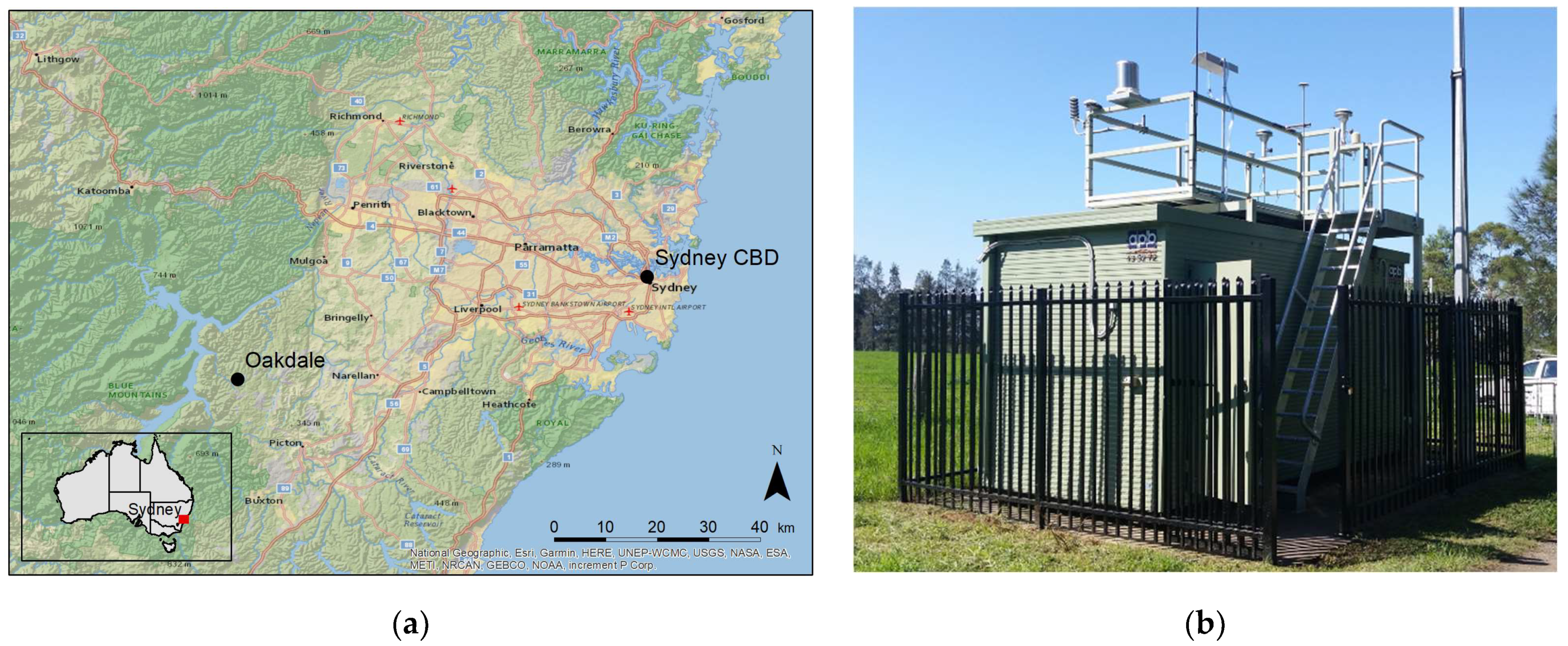
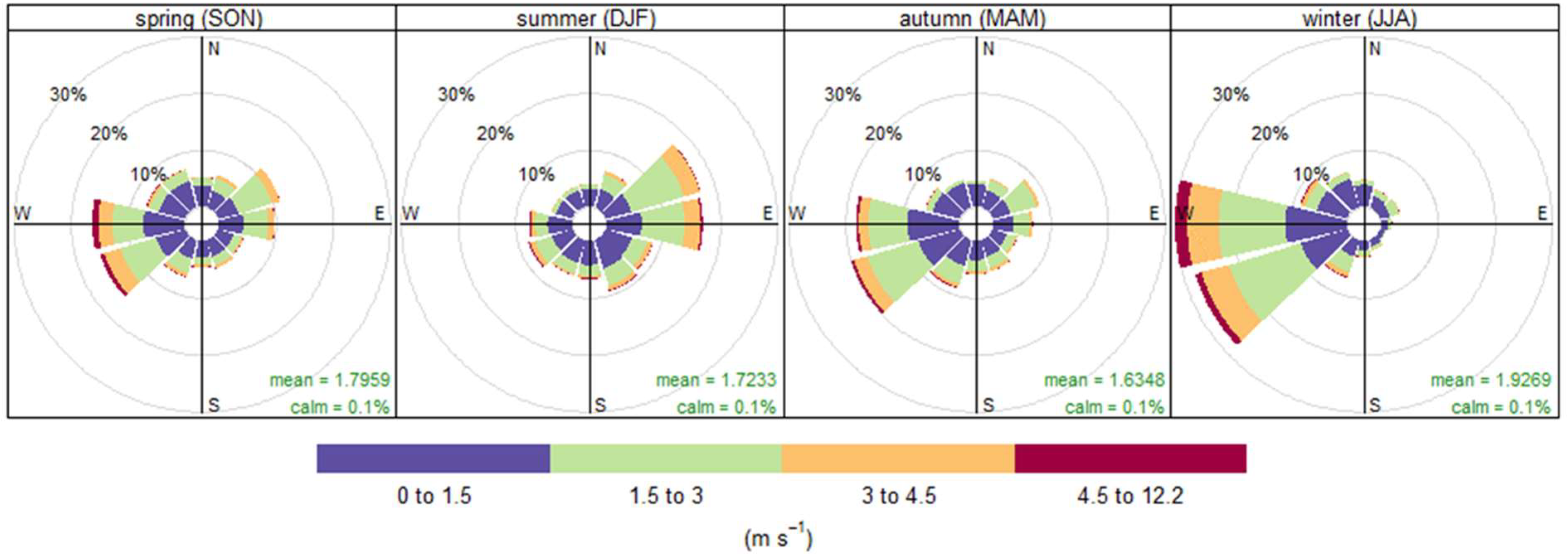


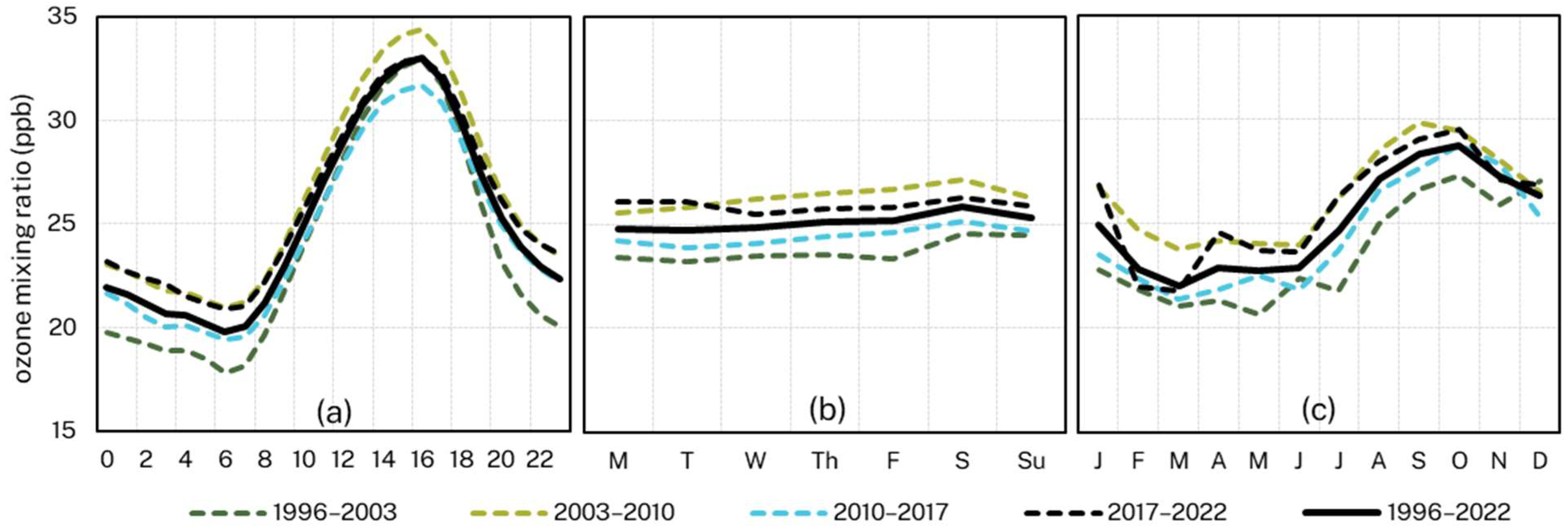
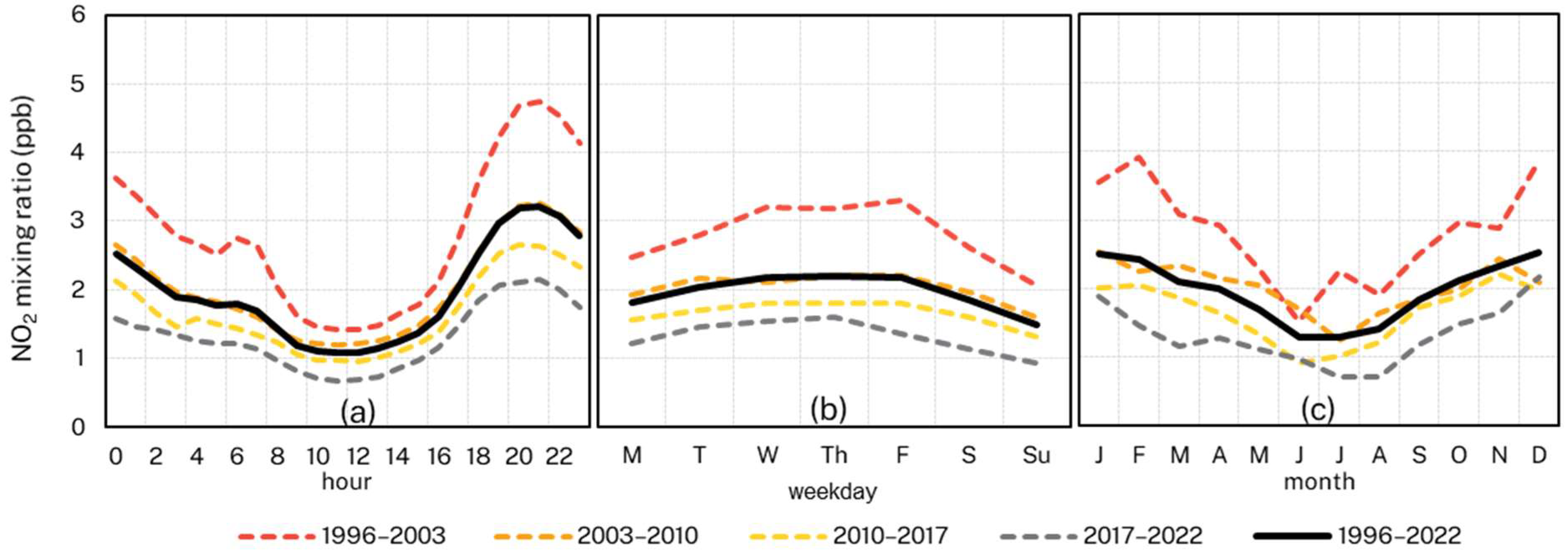
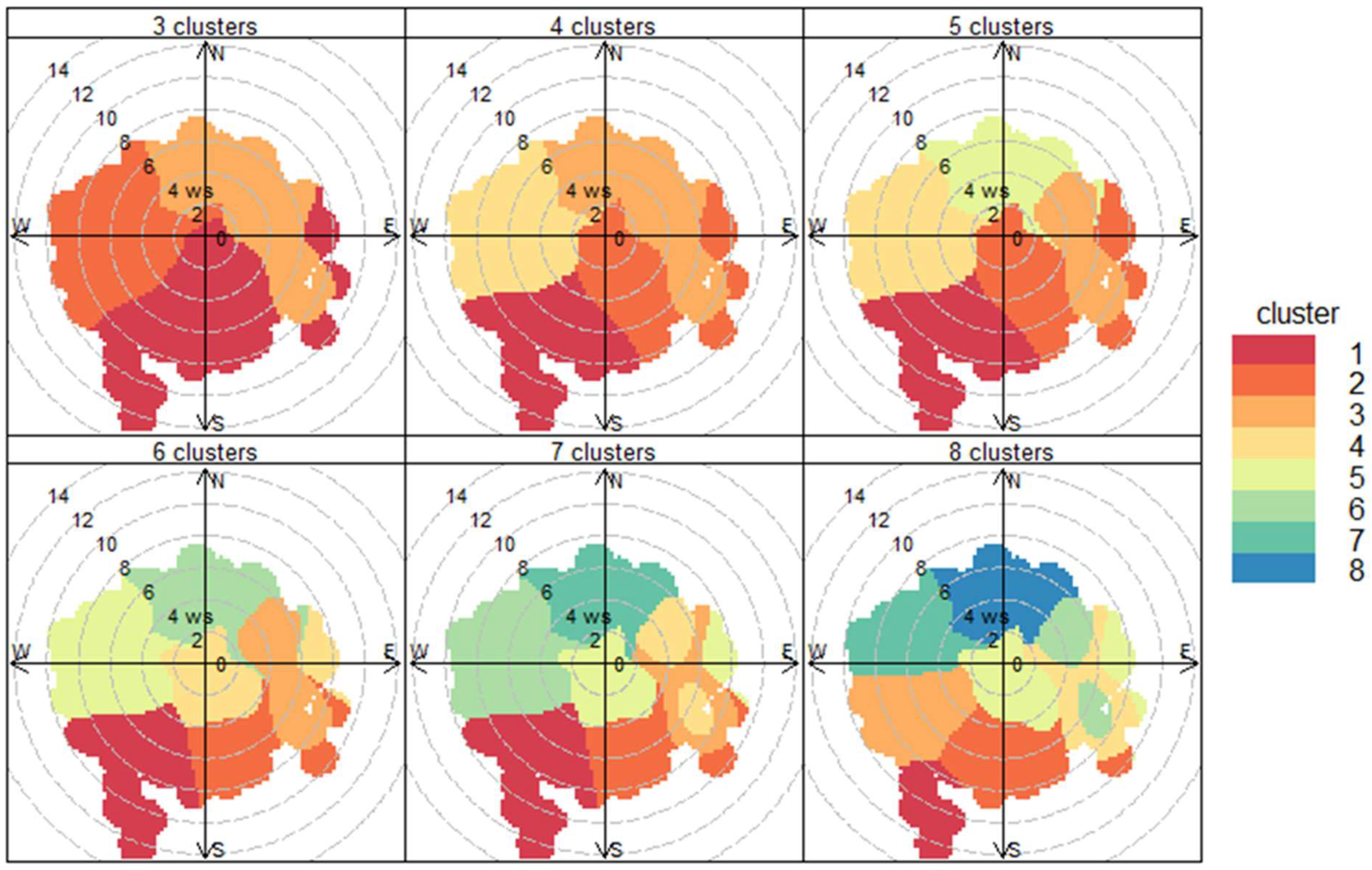

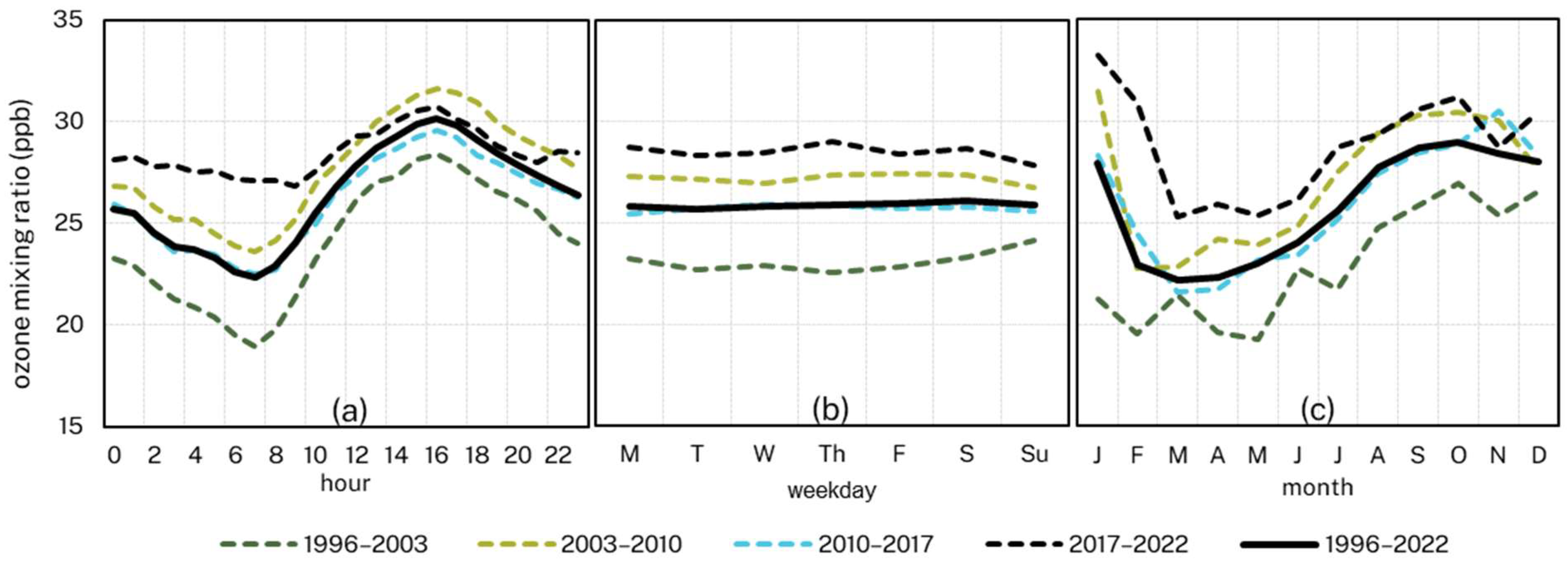

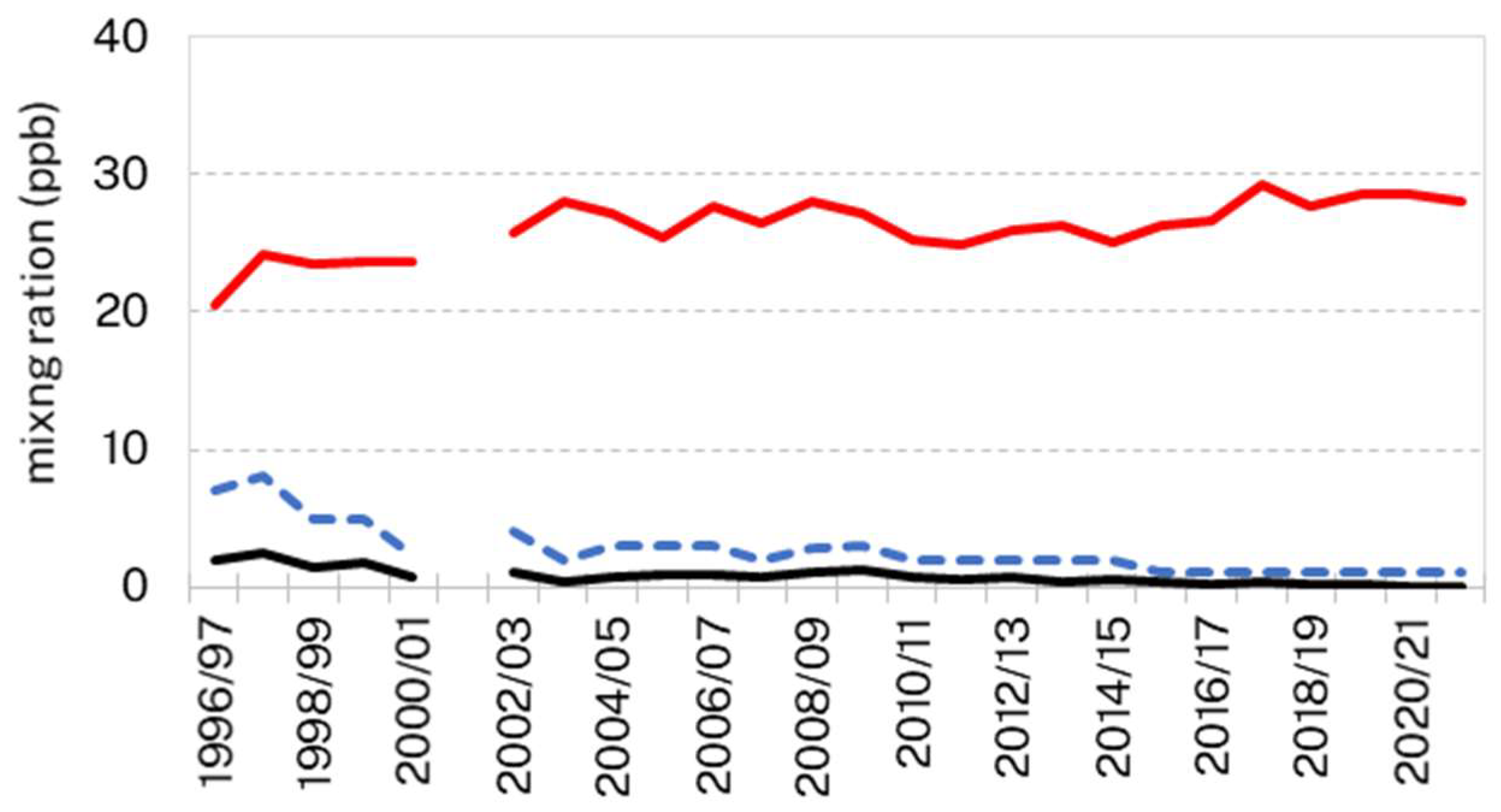
| Measurand | Instrument | Dates |
|---|---|---|
| ozone | TEI49C (Thermo Fisher Scientific, Franklin MA, USA) | 1 April 1996–11 April 2008 |
| EC9810 (Ecotech Pty. Ltd., Melbourne., Australia) | 12 April 2008–21 December 2015 | |
| API400T (Teledyne API) | 22 December 2015–present | |
| oxides of nitrogen | TEI42C (Thermo Fisher Scientific, Franklin MA, USA.) | 1 April 1996–11 April 2008 |
| EC9841 (Ecotech Pty. Ltd., Melbourne., Australia) | 12 April 2008–21 December 2015 | |
| API200T (Teledyne API, San Diego, CA, USA) | 22 December 2015–present | |
| particles (visibility) | M903 (Radiance Research) | 1 April 1996–approx. January 2005 |
| M9003 (Ecotech Pty. Ltd., Melbourne., Australia) | approx. January 2005–18 November 2011 | |
| Aurora 1000G (Ecotech Pty. Ltd., Melbourne., Australia) | 19 November 2011–present |
| Period | Valid Ozone Days | Annual | Warm Season (October–March) | Cool Season (April–September) | Peak Day-Time (12:00–18:00) | Night-Time (00:00–07:00) | ||||||||||
|---|---|---|---|---|---|---|---|---|---|---|---|---|---|---|---|---|
| O3 | NO2 | NO | O3 | NO2 | NO | O3 | NO2 | NO | O3 | NO2 | NO | O3 | NO2 | NO | ||
| 1996–2003 | 1760 | 23.6 | 2.8 | 0.7 | 24.3 | 3.4 | 0.9 | 22.9 | 2.2 | 0.6 | 30.9 | 2.1 | 0.7 | 20.7 | 3.2 | 0.8 |
| 2003–2010 | 2344 | 26.3 | 2.0 | 0.0 | 26.5 | 2.3 | 0.0 | 26.1 | 1.8 | 0.0 | 32.7 | 1.7 | 0.0 | 23.7 | 2.3 | 0.0 |
| 2010–2017 | 2507 | 24.4 | 1.7 | 0.0 | 24.9 | 2.0 | 0.0 | 24.0 | 1.3 | 0.0 | 30.2 | 1.4 | 0.0 | 22.1 | 1.8 | 0.0 |
| 2017–2022 | 1768 | 25.8 | 1.3 | 0.0 | 25.7 | 1.6 | 0.0 | 25.9 | 1.0 | 0.0 | 31.6 | 1.1 | 0.0 | 23.6 | 1.5 | 0.0 |
| 1996–2022 | 8379 | 25.1 | 2.0 | 0.1 | 25.4 | 2.3 | 0.1 | 24.8 | 1.6 | 0.0 | 31.3 | 1.6 | 0.0 | 22.5 | 2.2 | 0.0 |
| Period | Observations | Annual | Warm Season (October–March) | Cool Season (April–September) | Peak Day-Time (12:00–18:00) | Night-Time (00:00–07:00) | |||||||||||
|---|---|---|---|---|---|---|---|---|---|---|---|---|---|---|---|---|---|
| h | % | O3 | NO2 | NO | O3 | NO2 | NO | O3 | NO2 | NO | O3 | NO2 | NO | O3 | NO2 | NO | |
| 1 | 1645 | 1% | 26.1 | 0.7 | 0.0 | 23.9 | 0.7 | 0.0 | 27.3 | 0.6 | 0.0 | 26.6 | 0.6 | 0.0 | 25.3 | 0.8 | 0.1 |
| 2 | 119,074 | 63% | 22.9 | 2.2 | 0.0 | 22.1 | 2.4 | 0.1 | 23.8 | 2.0 | 0.0 | 25.8 | 1.6 | 0.0 | 20.7 | 2.7 | 0.0 |
| 3 | 23,231 | 12% | 34.5 | 2.5 | 0.1 | 35.9 | 2.6 | 0.1 | 30.3 | 2.2 | 0.1 | 36.1 | 2.4 | 0.1 | 21.9 | 3.3 | 0.0 |
| 4 (background) | 46,322 | 24% | 25.9 | 0.9 | 0.0 | 27.2 | 1.3 | 0.1 | 25.4 | 0.8 | 0.0 | 27.3 | 0.7 | 0.0 | 24.6 | 1.1 | 0.0 |
| Period | n (h) | Annual | Warm Season (October–March) | Cool Season (April–September) | Peak Day-Time (12:00–18:00) | Night-Time (00:00–07:00) | ||||||||||
|---|---|---|---|---|---|---|---|---|---|---|---|---|---|---|---|---|
| O3 | NO2 | NO | O3 | NO2 | NO | O3 | NO2 | NO | O3 | NO2 | NO | O3 | NO2 | NO | ||
| 1996–2003 | 11,521 | 23.1 | 1.6 | 0.8 | 24.3 | 2.0 | 1.0 | 22.6 | 1.5 | 0.7 | 23.1 | 1.6 | 0.8 | 21.9 | 2.0 | 0.8 |
| 2003–2010 | 13,538 | 27.2 | 0.9 | 0.0 | 28.0 | 0.9 | 0.0 | 27.0 | 0.8 | 0.0 | 27.2 | 0.9 | 0.0 | 25.9 | 1.0 | 0.0 |
| 2010–2017 | 12,825 | 25.7 | 0.5 | 0.0 | 27.6 | 0.8 | 0.0 | 25.1 | 0.5 | 0.0 | 25.7 | 0.5 | 0.0 | 24.6 | 0.6 | 0.0 |
| 2017–2022 | 6313 | 28.5 | 0.2 | 0.0 | 29.7 | 0.4 | 0.0 | 28.1 | 0.2 | 0.0 | 28.5 | 0.2 | 0.0 | 27.9 | 0.3 | 0.0 |
| 1996–2022 | 44,197 | 25.9 | 0.9 | 0.0 | 26.9 | 1.1 | 0.1 | 25.5 | 0.8 | 0.0 | 25.9 | 0.9 | 0.1 | 24.6 | 1.1 | 0.1 |
| Statistic | Background O3 | Background NO2 | ||||
|---|---|---|---|---|---|---|
| Z-Test | Significance | Sen’s Slope and 95% Confidence Interval (ppb/year) | Z-Test | Significance | Sen’s Slope and 95% Confidence Interval (ppb/year) | |
| Annual mean | 3.34 | *** | 0.18 (0.10–0.28) | −5.28 | *** | –0.06 (–0.07 to –0.05) |
| Median | 2.97 | ** | 0.14 (0.00–0.22) | −3.90 | *** | –0.05 (–0.07 to –0.00) |
| Standard deviation | −3.34 | *** | –0.08 (–0.12 to –0.04) | −5.88 | *** | –0.06 (–0.08 to –0.05) |
| 5th percentile | 4.59 | *** | 0.41 (0.29–0.53) | 0.07 | --- | --- |
| 25th percentile | 3.87 | *** | 0.25 (0.14–0.36) | −0.96 | --- | --- |
| 75th percentile | 2.12 | * | 0.09 (0.00–0.20) | −3.73 | *** | –0.06 (–0.10 to –0.00) |
| 95th percentile | 1.67 | + | 0.15 (0.00–0.31) | −5.28 | *** | –0.17 (–0.21 to –0.13) |
| Annual maximum | −0.28 | --- | --- | −5.02 | *** | –0.58 (–0.82 to –0.44) |
Disclaimer/Publisher’s Note: The statements, opinions and data contained in all publications are solely those of the individual author(s) and contributor(s) and not of MDPI and/or the editor(s). MDPI and/or the editor(s) disclaim responsibility for any injury to people or property resulting from any ideas, methods, instructions or products referred to in the content. |
© 2023 by the authors. Licensee MDPI, Basel, Switzerland. This article is an open access article distributed under the terms and conditions of the Creative Commons Attribution (CC BY) license (https://creativecommons.org/licenses/by/4.0/).
Share and Cite
Riley, M.L.; Jiang, N.; Duc, H.N.; Azzi, M. Long-Term Trends in Inferred Continental Background Ozone in Eastern Australia. Atmosphere 2023, 14, 1104. https://doi.org/10.3390/atmos14071104
Riley ML, Jiang N, Duc HN, Azzi M. Long-Term Trends in Inferred Continental Background Ozone in Eastern Australia. Atmosphere. 2023; 14(7):1104. https://doi.org/10.3390/atmos14071104
Chicago/Turabian StyleRiley, Matthew L., Ningbo Jiang, Hiep Nguyen Duc, and Merched Azzi. 2023. "Long-Term Trends in Inferred Continental Background Ozone in Eastern Australia" Atmosphere 14, no. 7: 1104. https://doi.org/10.3390/atmos14071104
APA StyleRiley, M. L., Jiang, N., Duc, H. N., & Azzi, M. (2023). Long-Term Trends in Inferred Continental Background Ozone in Eastern Australia. Atmosphere, 14(7), 1104. https://doi.org/10.3390/atmos14071104









